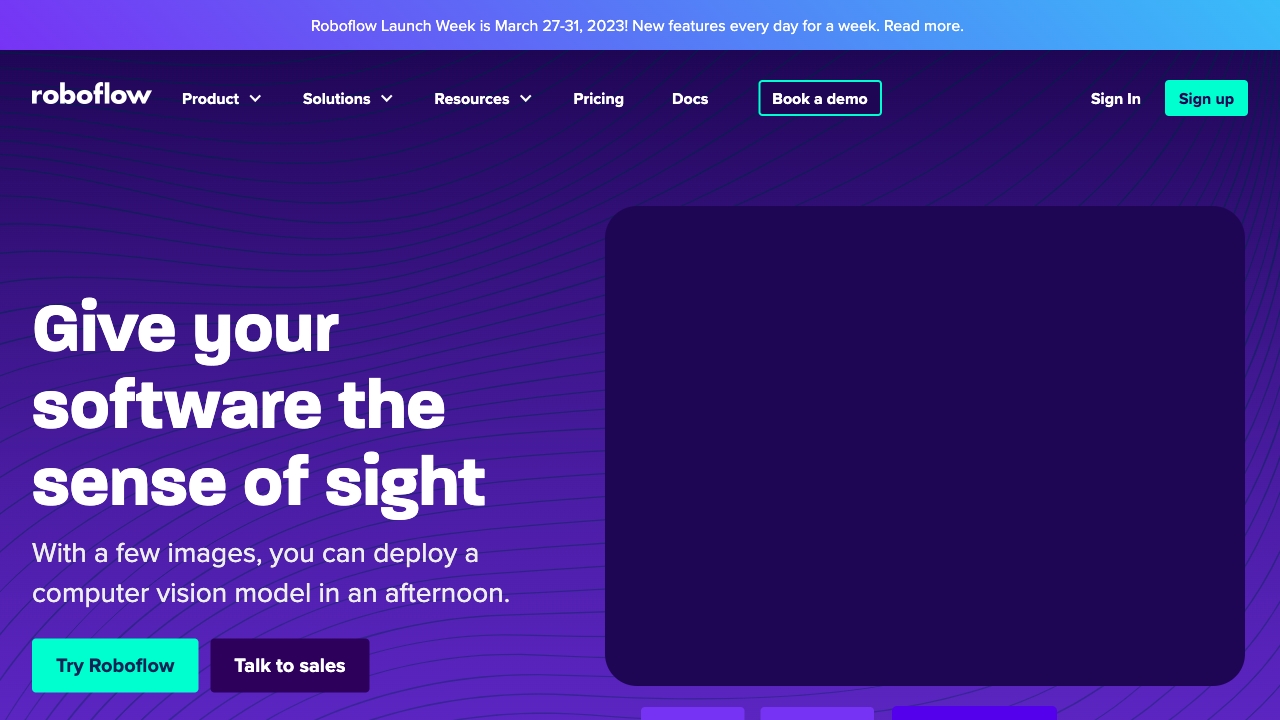- Home
- AI Image Recognition
- Roboflow

Roboflow
Open Website-
Tool Introduction:End-to-end computer vision: data curation, training, edge deploy.
-
Inclusion Date:Oct 21, 2025
-
Social Media & Email:
Tool Information
What is Roboflow AI
Roboflow AI is an end-to-end computer vision platform for developers and enterprises to transform images and video into production-grade AI. It unifies data curation, collaborative labeling, automated annotation, model training, evaluation, and deployment in one streamlined workflow. Teams manage datasets with versioning, benchmark models with clear metrics, and ship inference via cloud APIs or edge devices. Supporting object detection, classification, and segmentation, Roboflow accelerates computer vision roadmaps, reduces engineering overhead, and offers expert guidance to move from prototype to real-world performance.
Roboflow AI Main Features
- Data import and curation: Ingest images and video frames, de-duplicate, clean, and version datasets with robust metadata for reproducible experiments.
- Automated and collaborative annotation: Model-assisted labeling, label suggestions, and QA workflows speed up annotation while maintaining consistency.
- Augmentation and preprocessing: Built-in transforms and pipelines improve model robustness and reduce overfitting across varied environments.
- Model training infrastructure: Train state-of-the-art architectures for detection, classification, and segmentation with sensible defaults and tunable hyperparameters.
- Model evaluation and benchmarking: Compare versions with standardized metrics, confusion matrices, and error analysis to guide iteration.
- Deployment options: Serve models via hosted inference APIs or export for edge deployment to devices such as GPUs, embedded boards, or mobile.
- Monitoring and active learning: Capture failure cases, track drift, and feed new data back into the training loop to improve accuracy.
- Integrations and APIs: SDKs and REST APIs connect to MLOps tools, CI/CD, and production apps for seamless computer vision pipelines.
- Governance and collaboration: Role-based access, project sharing, and audit-friendly dataset versioning for team and enterprise needs.
Roboflow AI Suitable For
Roboflow AI suits software engineers, ML practitioners, product teams, and operations leaders who need reliable computer vision—whether rapidly prototyping or scaling to enterprise production. Typical scenarios include automating visual inspection, real-time detection on the edge, video analytics, and building vision-powered features in web or mobile apps.
Roboflow AI Usage Steps
- Import images or video frames and organize them into a project with clear classes and metadata.
- Label data collaboratively; use automated annotation and QA checks to speed up and standardize labels.
- Configure preprocessing and augmentation to reflect real-world conditions.
- Train a model using the built-in training workflows; adjust hyperparameters as needed.
- Evaluate performance with metrics and error analysis; compare against previous versions.
- Deploy the selected model via hosted inference API or export for edge targets.
- Monitor results in production, capture misclassifications, and iterate with active learning.
Roboflow AI Industry Cases
In retail, teams detect products and monitor planogram compliance on shelves. Manufacturers use it for defect detection and safety compliance on assembly lines. Logistics operations automate parcel identification, barcode reading, and load verification. Agriculture teams track crop health and count yields from aerial imagery. Smart cities analyze traffic flows and detect road hazards using edge cameras.
Roboflow AI Pricing
Roboflow AI offers tiered plans that typically include a free option for getting started and paid plans for professional teams and enterprises. Paid tiers expand private projects, labeling seats, training capacity, deployment limits, and support. Trials or credits may be available to evaluate training and deployment before scaling.
Roboflow AI Pros and Cons
Pros:
- End-to-end workflow from data to deployment in a single platform.
- Automated annotation and strong dataset versioning accelerate iteration.
- Flexible deployments across hosted inference and edge devices.
- Clear evaluation tools and experiment tracking guide model improvements.
- APIs and SDKs integrate with existing MLOps and application stacks.
Cons:
- Costs can increase with large datasets, high training volume, or heavy inference usage.
- Platform conventions may limit customization compared to fully bespoke pipelines.
- Vendor reliance for hosted services and updates.
- Focused on computer vision use cases rather than broader multimodal AI.
Roboflow AI FAQs
-
What model types does Roboflow AI support?
It supports common computer vision tasks such as object detection, image classification, and segmentation, with training workflows for modern architectures.
-
Can I deploy models to the edge?
Yes. You can export models for edge targets and deploy to on-device runtimes, as well as use hosted inference APIs for cloud workloads.
-
Do I need deep ML expertise to get started?
No. The platform provides guided defaults, automated labeling, and evaluation tools that help non-experts build baseline models quickly.
-
Can I bring my own data and labels?
Yes. You can import datasets and annotations, manage versions, and fine-tune models on your own data.
-
How is data privacy handled?
Projects can be managed as private with role-based access. Enterprise plans offer additional controls to meet security and compliance needs.



